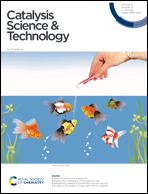CoP nanorods anchored on Ni2P-NiCoP nanosheets with abundant heterogeneous interfaces boosting the electrocatalytic oxidation of 5-hydroxymethyl-furfural†
Abstract
The transformation of biomass-derived platform molecules (such as 5-hydroxymethyl-furfural (HMF)) represents a renewable route to produce value-added chemicals and fuels. Herein, we report the design and fabrication of coralline-like CoP/Ni2P-NiCoP@NC materials composed of multiple metal phosphides embedded in N-doped carbon for efficient electrocatalytic oxidation of HMF to 2,5-furandicarboxylic acid (FDCA). Systematic characterization indicates that the materials possess strong electronic coupling between the abundant heterogeneous interfaces (i.e., CoP, Ni2P and NiCoP). Density functional theory (DFT) calculation results further suggest that the heterogeneous interfaces in CoP/Ni2P-NiCoP@NC can regulate the d-band centers of Co and Ni to approach the Fermi level, thus strengthening the electronic interaction at the reaction interfaces and minimizing the energy barrier of the rate-determining step for HMF electro-oxidation. Consequently, the optimal CoP/Ni2P-NiCoP@NC-600 exhibits excellent HMF oxidation activity with an ultralow potential of 1.32 V vs. RHE at 10 mA cm−2 in 0.1 M KOH, affording 98.1% FDCA yield and 97.6% Faradaic efficiency (FE) as well as robust cycling durability.



 Please wait while we load your content...
Please wait while we load your content...